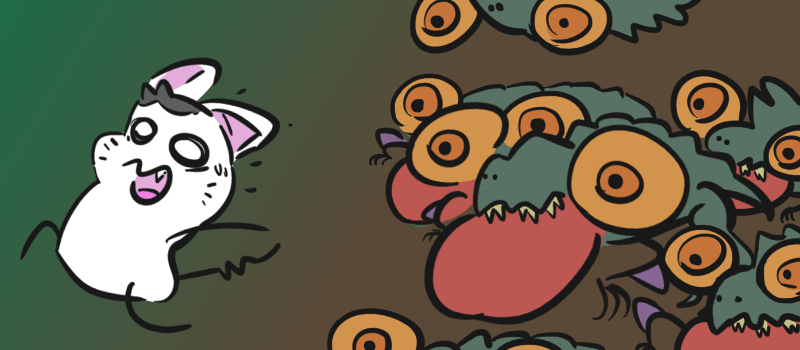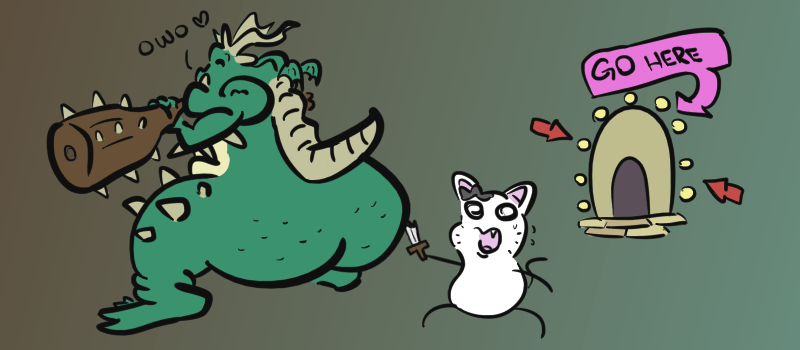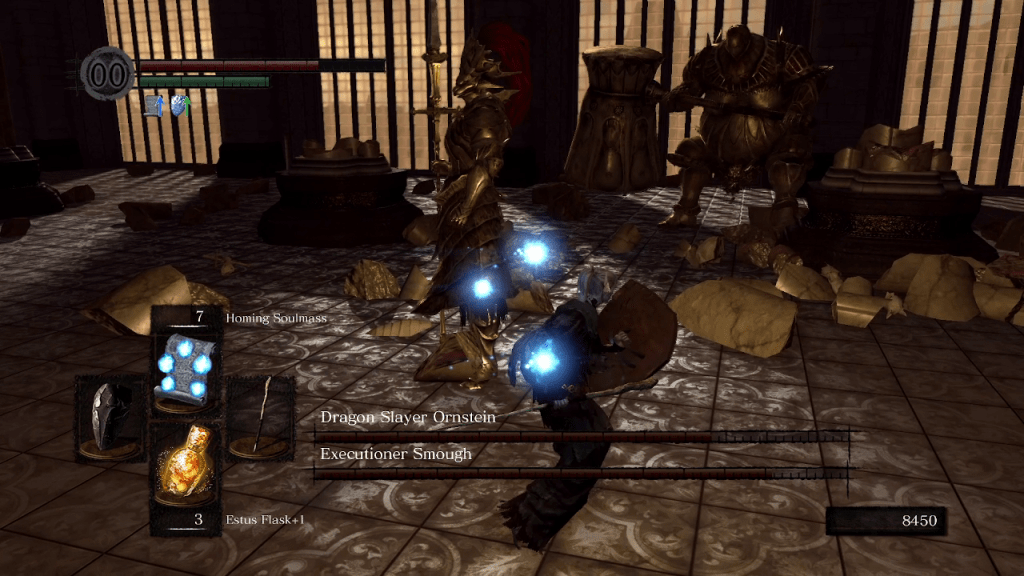For as long as I can remember I’ve been hearing about how hard Dark Souls is. The game was released back in 2011, and ever since has largely dominated the discourse of video game difficulty. It’s annoyingly common to hear comparisons to Dark Souls as a means to express a title’s level of challenge. There are also a number of outspoken individuals who treat beating it like a sacred badge of honour. Only a true Chadimus Prime gamer bro could possibly beat such an imposingly difficult game. Obviously. Thus, Dark Souls has cemented itself in pop culture as the de facto hard video game.

It is thanks to this cultural status that I was convinced for the longest time that Dark Souls was indeed the pinnacle of difficult games. Why else would people continually rely on the same example for over a decade? It’s not like there hasn’t been an ample supply of challenging games such as Cuphead, XCOM 2, Nioh, or Celeste to use as more recent points of comparison. This gave me the false impression that Dark Souls was uniquely challenging in ways no other game was. I have to imagine I wasn’t alone in thinking this way, and for the longest time that was part of why I never gave the game a shot.
Despite my apprehension, I did recently play through the title. I wasn’t alone however, as I enlisted my friend Meghan to help along the way. After finishing Dark Souls twice, I’ve ultimately concluded that I like it very much. However, I also found it to be a lot easier than I was anticipating, which I still haven’t mentally recovered from. The game rewards patience and lateral thinking quite heavily, not unlike a variety of other games I’ve played. While it may have felt alien in 2011, Dark Souls is right at home alongside all the games it inspired. With all that said, here’s how I became a Souls Shitboi.
You want to know the quickest way to win me over to the dark side? No map. I really enjoy navigating without a map, as there’s something oddly satisfying about learning the intimate details of a space. Some may dismiss this enjoyment for nostalgia, but I even enjoy exploring this way outside of games. Hell, one of the most exciting discoveries I made in recent memory was finding a donut shop a stone’s throw away from Mir’s place. While there aren’t any donut shops in Dark Souls, I had a similar level of enjoyment working out how each zone fit together to make up Lordran.
I think my favourite of these navigation based epiphanies happened when I left Blighttown. The trek down to Blighttown is truly notorious. Players first have to squeeze through a maze of tight corridors filled to the brim with basilisk (henceforth Testicle Jim). Afterward, they’ll arrive at the peak of Blighttown: a village precariously built into the side of a cliff over a poisonous swamp. It was constructed almost entirely out of rotting wood, so any misplaced steps can send players crashing to their death. After finally making it to the base of this shitheap, one must trudge slowly through waist deep poisonous sludge. It’s no wonder everyone thinks Blighttown is the worst.

The trip into Blighttown is indefensibly awful, and the prospect of climbing out the same way I entered was enough to make my stomach turn. However, if you explore the swamp you’re likely to stumble upon a second entrance into Blighttown which connects to the Valley of the Drakes. What’s important here is that right across from said entrance is a shortcut that leads back to Firelink Shrine, the central hub area, through the New Londo Ruins. Ah ha! So there’s a back entrance into Blighttown that allows safe passage without the need to take on the Testicle Jim armade, or Blighttown’s questionable construction. Excellent. I shall use this knowledge to my advantage!
It’s not just how the lands of the Undead connect that makes them interesting to explore – how locations are oriented plays a factor too. Many areas are stacked vertically atop one another, which at first glance doesn’t seem like a noteworthy detail. However, it eventually becomes apparent that when you descend further you’ll only be greeted by increasingly decrepit environments. As such, each of these areas feels like they fell, and were then built upon by a successive group. The ruins of Lost Izalith give way to the swamp village of Blighttown, which itself is buried beneath the sewers of the Undead Burg. This helps give Lordran a real sense of history. You’re not just exploring some crumbling shithole; You’re uncovering the stories of once prosperous civilizations that have fallen to ruin.
This kind of wordless environmental storytelling is my favourite. Nothing ruins the vibe of a game for me faster than an NPC with verbal diarrhea. Finding details as I explore, and drawing my own conclusions is a lot more satisfying to me than simply being told the story of a place. Dark Souls leans really heavily into this idea, and as a result I found myself thinking about the places I’d been in Lordran and the stories of its denizens a lot more than I typically do in other games.
Unfortunately, not every area in the game was given the same level of polish, which hampers the consistency of the environmental story-telling. The best worst example of this is Lost Izalith. While conceptually neat, these lava filled ruins were very clearly rushed in development. Enemies feel like they were placed at random, and several early game bosses make reappearances here in large herds. When so much care was put into the rest of the game, the lack of any attention to detail makes Lost Izalith feel as though it was thrown together to meet a deadline.

While Lost Izalith is a lost cause, the rest of Lordran is home to a variety of cleverly designed encounters. One of my favourites was the lonely, unassuming scrungle off in the distance with their back to you. When players rush forward they’ll likely be jumped by foes waiting to ambush them. While punitive, I always thought getting dunked on like this was more funny than discouraging. It also started a cat and mouse game where I would try to predict traps, cheering when I was successful, and laughing at myself when I wasn’t. Not all encounters are like this, but there are enough traps and ambushes sprinkled in among standard combat engagements to keep things interesting.
Speaking of combat, while the actual mechanics of combat are dead simple, the way that Dark Souls rewards lateral thinking isn’t. The least spoilerino example of this happens during the game’s tutorial. After learning about the game’s basic controls and checkpoint system, you’ll enter an empty room only to be greeted by a surprise attack from Lord Chonko the Great as he drops down from the ceiling. You’re equipped with a broken sword and no armor, so you’re not likely to win in a head-on confrontation at this point in the game. However, Dark Souls doesn’t expect you to slowly chip down Chonko by slapping his immaculate ass cheeks with your broken kitchen knife. Rather, it wants you to examine your surroundings and reassess the situation.
While it is possible to beat Lord Chonko with your shitass broken blade, there is a far easier solution that FromSoft is banking on. Upon entering the boss arena, players should notice an open doorway on the far side of the room. There is nothing stopping them from saying, “fuck this” and running through said doorway to bypass direct confrontation. It’s also worth noting there is a tutorial tip in this room that reads, “Get away!” just in case you needed the extra nudge. Afterward, players can finish the remainder of the tutorial, which will award them with a proper set of armor, and a weapon. Now they can re-enter Chonko’s arena fully equipped for battle. This turns the otherwise impossible fight into one that is far more manageable, while also cementing a lesson about the value in approaching problems from alternative angles.

Also, to clarify, while I thought the core combat mechanics were simple, I’d be lying if I said I didn’t enjoy it. Combat is almost exclusively reactionary, so it feels a lot like playing rock, paper, scissors, albeit in slow motion. Enemy attacks have huge amounts of wind up, which gives the player ample opportunity to select and execute the appropriate counter measure. Thankfully, enemies do absolutely nuclear levels of damage, so many of the game’s encounters still retain a nice level of tension. This helps to keep combat engaging across the experience, instead of falling into repetitive tedium.
One area I expected to enjoy more with Dark Souls was the boss fights. I didn’t think any of them were bad, but I expected more from them. One of the most pervasive memes for these games is a significant supply of jokes about how difficult the bosses are. Unfortunately, I found most of them fairly straightforward. In a lot of ways I felt like I was playing a simplified version of Monster Hunter, which might actually be why I felt so at home fighting the majority of them. They were all visually impressive, but I don’t feel like I formed as much of a bond with them as many players had on their first journey through Lordran.
Having said all of that, there is one exception. The infamous fight against Ornstein and Smough is one of the most challenging things Dark Souls has to offer. It pits you against two of the hardest bosses in the game simultaneously. Their attacks perfectly compliment one another with one using slow, mighty strikes, while the other does quick elemental attacks. I’m still of the mindset that this fight is very intentionally designed to lure players into finally leveraging co-op, due to how inherently unfair it is to fight the two knights by yourself. That said, the build up to this fight an+d the player’s eventual victory really stands out as one of the highest highs of Dark Souls.

Speaking of co-op, it was during this fight that I realized how awesome the co-op in Dark Souls is. Being a stubborn fuck I decided I was going to solo the terrible twins, but I wanted some additional practice that didn’t feel so self-defeating. As such, I placed my co-op banner down to assist other players. And I did. Holy moly. For a game that is as dour as Dark Souls, there is something incredibly uplifting about seeing anonymous players helping one another overcome the game’s challenges. I never would have thought someone else’s success would feel more meaningful than my own, but here we are.
I believe that covers all the thoughts I had on Dark Souls after finishing it. Thrice. It’s a really fun game, and I’m disappointed I was put off by its reputation for so long. It ended up being a game where the level of challenge resulted in an engaging experience, rather than one where it was oppressively difficult. I definitely think more folks should give the game a try, doubly so if they can get someone to help as a guide for their first time through. Meghan was a huge help for me as I was able to ask questions and get direct answers without spoiling other parts of the game for myself. Plus it was fun to have someone to laugh with through the insanity.
Edited by Meghan (Meghan Plays Games)

I will never emotionally recover from you rolling off the top of Sen’s Fortress.
LikeLiked by 1 person
In my pure magic build playthrough something even dumber happened
I got to the top with a pixel of health and no estus. Dropped down to the fire thinking I was home free, and the fucking fall damage killed me.
Worst part? I coulda just popped a humanity to restore my health T_T
LikeLiked by 1 person
I do agree that ppl ‘over hype’ how hard dark souls is.Like even with Elden ring people are saying it’s a bad game because it is difficult when it really is the most accessible souls game to date. I think as long as you are not reckless like just attacking wildly and watching for patterns then souls isn’t super hard. I think people need to also expect that they will die like it is the way it is. You die and get better because u learn from knowing why u died
LikeLiked by 1 person
I’m always happy when people get into Dark Souls. As someone who’s been playing the games and consuming content about them for a long time now, it’s always fun to hear about first-time experiences with the franchise. Whether your journey ends with DS1 or continues into the rest of the games, this was a nice experience to read about.
LikeLiked by 1 person
Great read as usual.
I always saw the Dark Souls games as less ”hard” and just more punishing for slip ups. The idea of a “hard” game is all about perspective.
For example, the people who run around claiming they are great because they can plow through a Dark Souls game would get demolished in a game of Civ 6 on Diety level but Civ 6 isn’t considered a “hard” game. Anyone can get to that point, its a matter of how much time and dedication they are willing to commit to learning the various game mechanics.
I liked your comparison to Monster Hunter though, from everything I have seen and/or played of both games it seems that the combat in both games that would appeal to the same type of person.
LikeLiked by 1 person
The main root of that is likely that Civ has the ability to choose a difficulty, while folks still think Dark Souls doesn’t. Mid-flight on another piece where I hope to dispel that myth because playing with coop, and magic is absolutely the easy mode compared to bashing your skull against the same wall for hours like a degenerate.
I’m also fairly certain a number of people would challenge that comparison, but a lot of the high level concepts are applicable to both even if the cadence is different. But the ol’ “dodge then hit and the game ain’t shit” applies to both, so…
LikeLike
I felt the same way when starting Dark Souls. I thought it was going to be this incredible difficult game, and then I realized that it wasn’t that bad. My intimidation mostly comes from exploring new areas for the first time, but once they are familiar then there is nothing for me to worry about. Blighttown is no longer a problem for me since I spent so much time there that I felt like a local resident.
LikeLiked by 1 person
As a counterpoint to ‘Dark Souls games aren’t actually that hard’, without even resorting to particular boss fights, — I offer up Dark Souls 2 — Shrine of Amana. That’s it. The whole argument. xD
More seriously, I’m with you. Even areas like that are more akin to puzzles to be solved rather than classically ‘difficult’.
Jumping back to the bosses; there are some across the series that *are* more classically difficult. Many of these are optional, but not all. By and large though, I also agree with your MH reference. My progression was from DS -> MH and it certainly helped get the jump on learning that series. 🙂
LikeLiked by 1 person
I think part of the problem might stem from so many of the mainstream darling titles kind of just…holding your hand endlessly, and Dark Souls doesn’t. There’s a handful of things you need to figure out, but once you do then you’re golden. In a lot of ways, the opening few hours I spent with the game reminded me of the hours of trial and error I go through with most rogue-likes or fighting games.
Well they both share a lot of concepts in common (some of which are also shared by fighting games). The basic idea of waiting to punish your opponent for locking into highly committal move is one that is shared among a lot of action-y games, but it doesn’t seem to be as widely understood. Maybe because so many games let the player decide the pace, whereas with Dark Souls the game is always setting the pace. Same goes for Monster Hunter, albeit with 4 hunters I feel like the hunters force the monster to play their game hahah
LikeLiked by 1 person